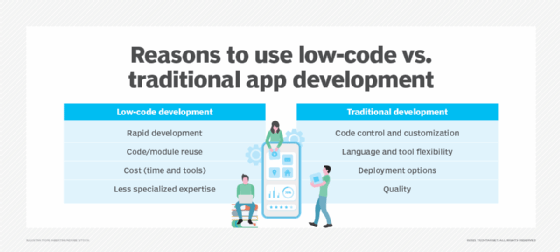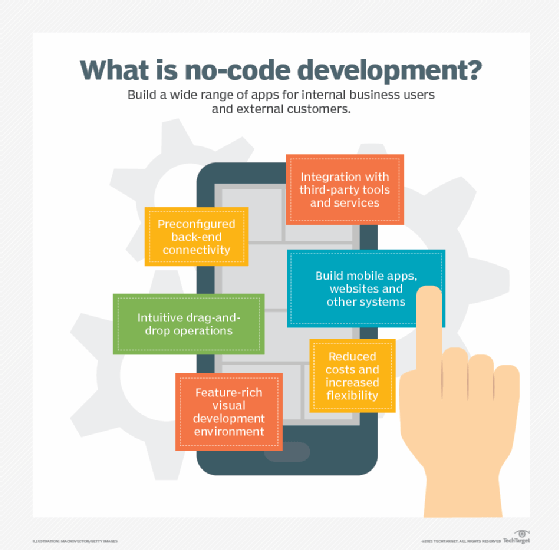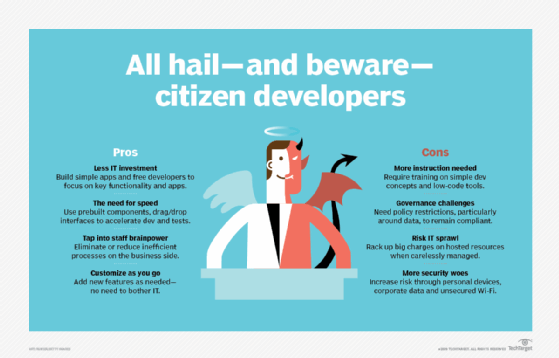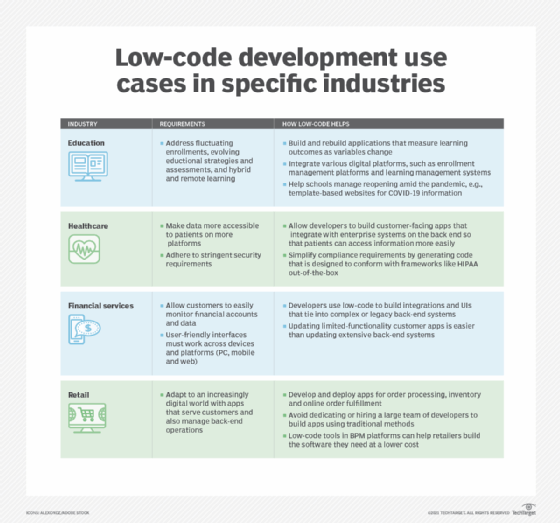low-code and no-code development platforms
What are low-code and no-code development platforms?
Low-code and no-code development platforms are software development tools and environments that allow enterprise developers and citizen developers to create new applications using drag-and-drop components, linking them together and creating mobile or web apps. These platforms are often discussed synonymously with the development methods they embody.
Who uses low-code/no-code technology?
Low-code and no-code modular approaches let professional developers quickly build applications by relieving them of the need to write code line by line. They also enable business analysts, office administrators, small-business owners and others who are not software developers to build and test applications. These people can create applications with little to no knowledge of traditional programming languages, machine code or the development work behind the platform's configurable components.
Why is low-code/no-code used?
Convenience, speed of development and cost control are among the reasons for using low-code and/or no-code development tools. Systems typically use a user-friendly graphical user interface, along with drag-and-drop features, to marry components and third-party application program interfaces (APIs). Application builders can rearrange and repeatedly test modules until the app works as expected.
The growth of low-code/no-code platforms has proliferated due to a continued lack of skilled software developers and the need to improve turnaround time for development projects so business problems can be solved quickly.
How do low-code and no-code work?
In conventional software development, programmers write lines of code to create the functions and features desired in a computer program or application. This process requires programmers to have in-depth knowledge of computer languages, as well as development environments, deployment processes and testing protocols.
Low-code and no-code platforms encapsulate all that work behind the scenes, usually called back office functions. Users visually select and connect reusable components that represent particular steps or capabilities (which contain the actual code), and link them together to create the desired computerized workflow.
Users can create applications as if they were drafting a flowchart rather than writing line-by-line codes for each desired function and capability. These platforms also generally have features that allow for experimenting, prototyping, testing and deployment. Their security features are especially important for protecting the new apps from potential cyberattacks.
This approach to app development is sometimes called point-and-click and often includes drag-and-drop interfaces to simplify the overall process.
Evolution of low-code/no-code tools
Low-code/no-code platforms stem from earlier rapid application development (RAD) tools such as Excel, Lotus Notes and Microsoft Access that similarly put some development-like capabilities into the hands of business users (i.e., non-IT professionals).
However, those tools required users to thoroughly understand the business apps and their development environments in order to build capabilities. In contrast, with low-code and no-code options' drag-and-drop features, users need either minimal or no knowledge of the tools or development in general.
Experience with low-code and no-code development indicates that for successful projects it is desirable to work with experienced programmers who can assist with the overall process, e.g., by identifying potential issues before the app is released.
From a production perspective, it is important to determine who will be using an app developed using such tools. For example, development with RAD tools generally produces capabilities used by the individual who creates the functionality, or by a limited number of users associated with the creator (e.g., a workgroup or business unit). By contrast, apps produced with low-code or no-code platforms might be robust enough to be used across departments and throughout the entire enterprise, and even by external users such as customers and business partners. Again, it is important to have access to experienced programmers who can review the app before it is put into production, especially at an enterprise level, and to ensure that security has been addressed.

Low-code vs. no-code development platforms: What are the differences?
Low-code and no-code systems offer the same fundamental benefits, but their names indicate the key difference between these two methods of application development.
Low-code development requires users to perform some level of coding, albeit much less than is required with traditional application development. Professional developers and programmers use low code to quickly deliver applications and shift their efforts away from commodity programming tasks to more complex and unique work that might have a bigger impact and more value to the organization. Non-IT professionals with some programming knowledge also use low-code tools to develop simple apps or expanded functions within an app.
No-code, also called zero code, development targets nontechnical users in various business functions who understand business needs and rules, but possess little or no coding experience and programming language skills. These citizen developers can use no-code to easily and quickly build, test and deploy their business apps and websites, as long as the chosen tools align with these commodity functions and capabilities.
There are also some distinctions in how users apply no-code and low-code. No code is typically used to create tactical apps to handle simple functions. Low code can be used in those cases as well, but additionally to create apps that run processes that are critical to a business or an organization's core systems, such as certain integrations and digital transformation initiatives.
The line between no-code and low-code isn't always clear -- and this carries over into the low-code and no-code platforms themselves. Many technology product analysts consider no-code part of the low-code market, as even the strongest platforms require some level of coding for parts of the application development and deployment process. Vendors drive much of the distinction between low-code and no-code platform capabilities as they position their products for different groups of customers.
Generally speaking, no-code platforms are a specialized type of low-code cloud platform in which the required visual components address industry-specific functions, a specific line of business (LOB) or support a specific company's corporate branding. Low-code platforms, on the other hand, may require the assistance of in-house developers to make small changes to back-end code so the new app will align with other business software. The figure below provides details on the elements in a low-code mobile application.

Citizen developers can deliver apps with mobile-specific features such as interfaces designed for smaller screens, offline caching and integration with enterprise mobility management systems. Again, it is important to enlist the support of experienced programmers during the development process to ensure the new app performs correctly and has security features enabled.
Benefits of low-code and no-code platforms
First and foremost, low-code and no-code platforms speed the development and delivery of applications -- a critical element in the digital age when organizations must race to meet worker and customer demands, or be disrupted by others who do so.
These platforms also put more problem-solving capabilities into the hands of non-IT professionals, so that everyday workers can more quickly and easily create business apps that help them do their jobs. Concerns about the availability of experienced programmers and coders underscore the importance of low-code and no-code tools to assist with development.
These platforms also free professional developers from mundane programming activities. Development teams can use these platforms to quickly create apps for business applications, process automation, and commodity functions and then tweak them to deliver even more value, or spend more time in the development process building custom apps or addressing other initiatives that provide differentiating value to their organizations.
An added benefit is reduced costs, as some tools are free while others might require a low-cost license.
Challenges of low-code and no-code platforms
Although many organizations embrace these platforms and development tools to rapidly develop new business apps, they also contend with the problems and challenges generated by these platforms.
Because these tools are low-cost and easy to use, organizational leaders can, and often do, lose track of what their employees are building. This could mean there's no visibility or oversight to the data being generated, used or even inappropriately exposed in apps. It also could contribute to more shadow IT.
Customization and scalability are often limited with low-code and no-code tools, and this must be considered when evaluating prospective products. The new app or website might deliver the bare minimum of functions, possibly impacting development time. If more capabilities are required, it might be necessary to increase the dependency on an experienced programmer.
Another potential challenge is how to manage, maintain and test these apps, as well as the potentially escalated infrastructure and storage costs associated with the proliferation of development activity enabled by these platforms.
Additionally, organizations might find that some tasks for which citizen developers or professional development teams have used these tools weren't well-suited to low-code and no-code methods or platforms, and this could represent a significant waste of resources.
Security features of low-code and no-code tools must be carefully evaluated, so that newly developed apps will have sufficient protection from unauthorized access or cyberattacks.

Uses for low-code/no-code development platforms
Low-code and no-code development platforms can be used to automate the creation of apps and websites for various business or technical purposes -- provided that the apps and/or websites have no complex programming requirements and require little or no customization.
These platforms can be used to develop apps aimed at operational efficiencies, such as computerizing manual and paper-based processes or contributing to business process management efforts. They can also be used to modernize legacy systems, thereby helping organizations advance their digital transformations, further their migration to the cloud or support their use of advanced technologies such as the internet of things (IoT), artificial intelligence (AI) and machine learning (ML). Building IoT and AI/ML into apps is another situation where the low-code/no-code tool might offer limited capabilities, and require the assistance of an experienced programmer.
Furthermore, these platforms can be used to create business apps used by workers, as well as apps used by business partners; they can also be used to create customer engagement apps.
Low-code development platform vendors
Dozens of mainstream and niche software vendors offer low- or no-code platforms, many of which run in the cloud. Review Gartner's "2023 Magic Quadrant for Enterprise Low-Code Application Platforms" for more details.
Below is an unranked, alphabetical list of the most common low-code platform vendors and tools:
- Appian.
- Claris FileMaker.
- Dwkit.
- Google AppSheet.
- Looker 7.
- Mendix.
- Microsoft PowerApps.
- OutSystems.
- Robocoder Rintagi.
- Salesforce Lightning.
- Skyve Foundry.
- SIB Visions VisionX.
- Wix Editor X.
- Yellowfin 9.
- Zoho Creator.

No-code development platform vendors
Many low-code platforms offer no-code functionality as well, such as Appian, Mendix, Microsoft PowerApps, OutSystems and Salesforce Lightning.
Other vendors that offer no-code development platforms include the following:
- Airtable.
- AppGyver.
- Google AppSheet.
- Appy Pie.
- Betty Blocks.
- Bubble.
- Carrd.
- Clickfunnels.
- Glide.
- Gumroad.
- Kartra.
- Kissflow.
- Memberstack.
- Notion.
- Outgrow.
- Payhere.
- Quickbase.
- Shopify.
- Stripe.
- Umso.
- Voiceflow.
- Zapier.
- Zudy Vinyl (Zudy acquired by Jitterbit in 2023).
The future of low-code/no-code application development
Industry experts predict the future of low code will see continued enterprise adoption, especially for fast development and specific business needs, although low code won't entirely replace traditional application development.

Analysts at Gartner project the low-code market to reach $44.5 billion in revenue by 2026, with a compound annual growth rate (CAGR) of 19.2% from 2021 through 2026. Specifically, the low-code platform segment is projected to expand to more than $18 billion in 2026, with a CAGR of more than 20%.
Low-code and no-code use is likely to increase among LOB workers, while professional developers will continue to use it as well to help them with less complex programming tasks.
According to Forrester, the top areas for low-code use continue to be business process or workflow applications, web and mobile front ends, and customer-facing applications. Experts predict that eventually low-code will expand into broader areas such as reengineering technology stacks and ecosystems.
Enterprises will continue to practice traditional development for applications that require extensive application functionality, data governance and deployment to specific architectures or environments. Security considerations are among the top issues to address, no matter how apps or websites are developed. Use of AI is expected to increase steadily, as many vendors today advertise the inclusion of AI features in their products.
See how AI affects low-code/no-code for DevOps. Further explore the low-code vs. traditional development and the rise of the non-developer. Read about low-code/no-code use cases for security and how to mitigate low-code/no-code security challenges.






